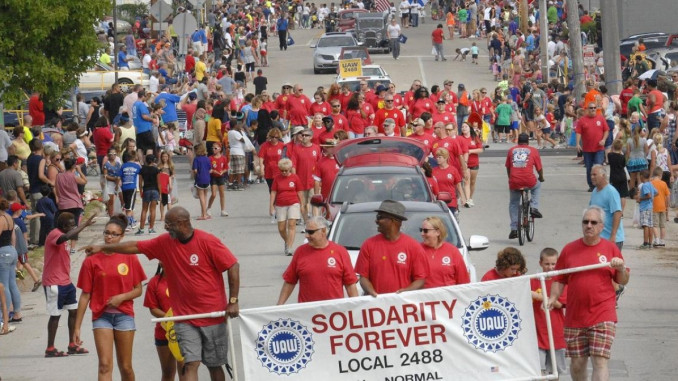
Labor Day is a holiday in the United States that supposedly celebrates the history and achievements of working people. Some politicians and union officials may give speeches celebrating the efforts of the nation’s working people, even as millions of workers are still forced to work on Labor Day.
For those lucky enough to get the day off, it may mean a day to relax or throw a BBQ with family and friends. Others will still work or volunteer to go in and get overtime. And for those that don’t have a job, it is yet another day of being unemployed.
Labor Day was born out of the fight for a shorter workweek. In the late 1800s, workers in the U.S. were forced to work long hours in factories with hazardous working conditions. Workdays of 12 hours or longer were not uncommon.
So workers began to organize. They built a movement around the fight for the eight-hour workday, a key concern for all workers. Their slogan was: “eight hours for work, eight hours for rest, eight hours for what we will.”
By 1886, the movement for the eight-hour day had intensified, and May 1, 1886 was chosen by workers’ organizations as a national day of strikes to win this demand. When the day came, strikes broke out across the country, involving 340,000 workers in 12,000 workplaces. Many strikes were victorious, winning reductions in the workday, if not the full eight-hour demand.
As a part of this wave of strikes nationally, a general strike was called in Chicago. After several days of striking and demonstrating, over 3,000 workers gathered in Chicago’s Haymarket Square, where they were surrounded by police. Given the strength of the strike in Chicago, the capitalists knew they needed to repress the workers in order to stop the strike.
Dynamite was thrown into the crowd of the demonstration, killing one cop and injuring more. After the dynamite went off, the cops opened fire on the crowd, killing and wounding several people.
This attack at Haymarket Square was used by the government as a pretext to either execute or imprison eight well-known leaders of the movement who were anarchists. These revolutionary worker activists were tried and convicted without evidence. Four were hanged as an example to workers throughout the country.
But the attempt of the capitalists to terrorize the working class didn’t work. In 1889, workers’ organizations from around the world declared May 1st as International Worker’s Day to honor the Haymarket martyrs and workers’ struggles across the globe.
Five years later in 1894, workers who built railroad cars at the Pullman Palace Car Company in Illinois went on strike to protest their 16-hour workdays and low wages. Workers across the country in the American Railway Union joined the strike in solidarity, causing rail traffic across the United States to screech to a halt. Troops were sent in by the federal government to end the strike with violence and protect the profits of the owners. Dozens were killed.
Recognizing that they had brutally repressed the Pullman strike, but that workers’ fights for improved conditions showed no signs of slowing down, the politicians knew they had to give workers a concession.
After the strike, Democratic Party President Grover Cleveland declared Labor Day a national holiday to supposedly honor workers. However, he purposely established the holiday in September, given most of the world was now celebrating International Worker’s Day on May 1st.
The ruling class in the U.S. created this new holiday to improve their image, but didn’t want it to be associated with the Haymarket massacre or the common struggles of workers internationally. Unfortunately, they have been successful to this day, as many workers in the U.S. have lost touch with this important history.
Ultimately, the history that led to the creation of Labor Day is a testament to the strength of unity and collective action. It shows that workers, when organized and determined, can challenge even the most entrenched systems of power. After all, despite repeated attacks by the bosses and the government, most of us in the U.S. do only work about eight hours a day. To honor our legacy and truly celebrate this holiday, we must continue to fight for what we and workers everywhere deserve.

